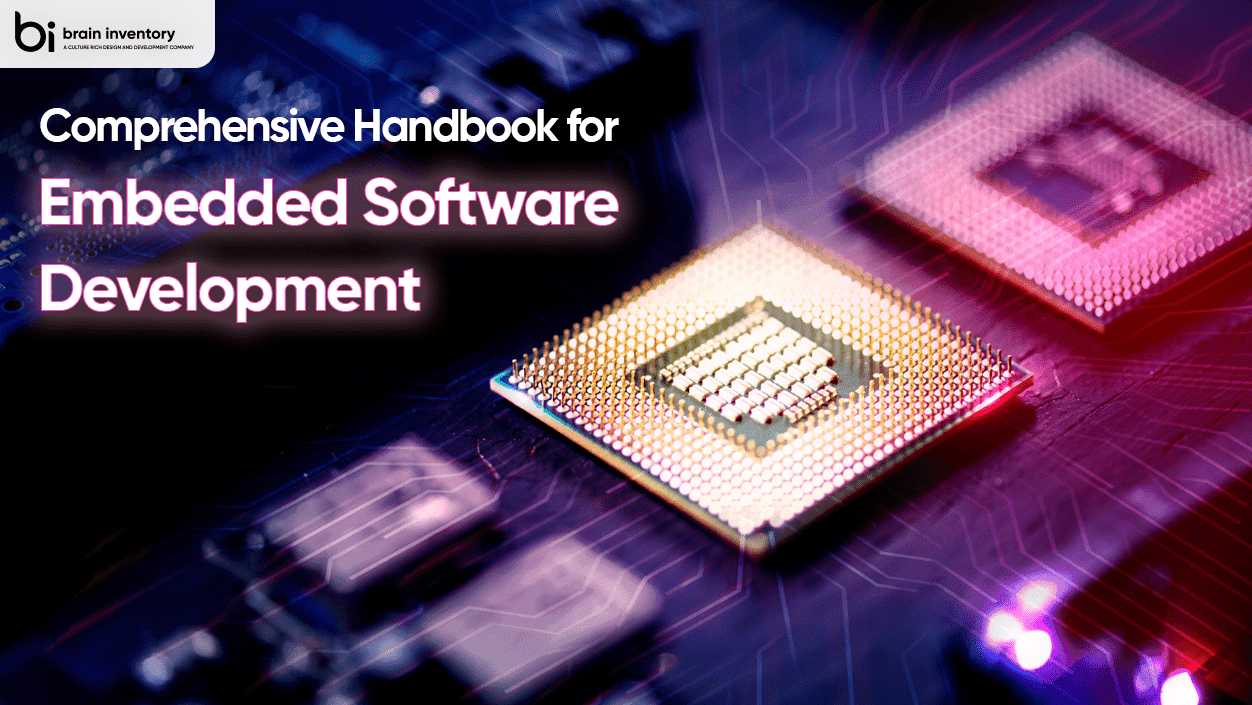Comprehensive Handbook for Embedded Software Development

Quick Summary: Embedded software development is becoming one of the most popular job opportunities in today’s technology-driven landscape. The demand for embedded software has increased because of the evolution of industrial automation. With growing applications in consumer electronics and manufacturing, embedded software is emerging as one of the most reliable tools to develop intelligent and interconnected devices. Therefore, entrepreneurs venturing into embedded software development can reap benefits like huge revenue, rapid revenue growth, and high returns on investment (ROI), apart from achieving greater visibility and market recognition.
Exploring Embedded Software Systems: Types and Their Key Roles
One of the most crucial elements of embedded systems is the hardware. This comprises electronic components and microprocessors that process the software instructions and perform complex operations. While software programs handle the activities on the computer, embedded systems are more concerned with their physical processes and are usually specific to a single function.
Embedded systems are computer-based devices that perform specific functionalities. These are used for automating repetitive tasks and controlling machines and processes. These systems collect data from environment sensors and as a result, can reduce errors and improve operational efficiency.
Now, let’s explore the various types of embedded software systems that play a vital role in today’s interconnected world. Take a closer look:
Firmware:
Smart devices are able to manage their major functions via firmware. Firmware is software that’s permanently contained in hardware, and it’s used to manage booting, low-level operations, and maintaining hardware interfaces. The term ‘firmware’ first appeared in the 1970s with IBM mainframes since they also have firmware that controls low-level functions.
Device Drivers:
Device drivers are essential parts of the operating systems. Without a device driver, it is impossible to connect different hardware components of a computer to its operating system. A device driver serves as an interface between an operating system and the hardware that enables it to communicate with the Operating System.
Real-Time Operating Systems:
Real-time operating systems, or RTOS, is a software running on an embedded system that enables the device to perform multiple tasks. It is mainly responsible for scheduling and managing the tasks, thus ensuring the correct execution of all the applications. This will ensure that the applications are running at the desired speed.
Middleware:
Middleware is an application that sits between two software components and facilitates communication between them. It guarantees that communication occurs in a predefined manner. In this way, middleware simplifies applications and allows developers to focus on their software’s core functionalities.
Embedded Linux:
Embedded Linux is one of the most popular operating systems for embedded devices. It is an established platform for different devices such as industrial controllers, digital television platforms, and in-car entertainment systems. The widespread use of these devices has made embedded Linux a popular choice among device manufacturers as it offers a flexible framework to develop consumer products that can function on a variety of hardware platforms and support a host of peripherals. The OS also delivers the required level of reliability, performance, speed, and configuration options for these devices.
Enhancing Business Efficiency with Embedded Software Systems
Embedded software systems have the potential to significantly enhance business efficiency by enhancing processes, automating operations, and optimizing resource utilization. Here are several ways in which embedded software can elevate operational effectiveness in businesses:
Real-Time Monitoring and Control
To effectively compete in the business arena, it is crucial to track live data. Real-time information, which was previously unavailable to many businesses, offers businesses a significant opportunity for growth and success. By installing sensors across all critical operations of manufacturing and production, data can be collected and used at a moment’s notice to improve processes, offer new services, and avoid costly disruptions.
Data Analytics and Insights
Embedded software is the key ingredient when it comes to gathering data from sensors and other devices. This ensures reliable and accurate results which form the basis for information-enabled business decisions. You can use these insights to gain a competitive edge, improve operational efficiency, reduce risks, and drive positive business outcomes.
Process Automation
Embedded software is the key ingredient when it comes to gathering data from sensors and other devices. This ensures reliable and accurate results which form the basis for information-enabled business decisions. You can use these insights to gain a competitive edge, improve operational efficiency, reduce risks, and drive positive business outcomes.
Integration with Existing Business Systems
Embedded software refers to specially designed software that is a part of other software. It is packaged with other systems, which allows it to run when the other software runs. Embedded software is built into hardware or operates adjunctly with a user’s primary application. It seamlessly integrates with existing business systems like customer relationship management (CRM) systems, enterprise resource planning (ERP) software, and online booking reservation software. These integration options not only enhance overall business coordination and communication but also facilitate smooth data flow. This also helps to reduce cost as the same program can be used by different businesses with minimal customization needs that need not be done every time the system is upgraded for the most part.
Remote Management and Connectivity
Embedded software systems make it easier for users to manage devices from remote locations. This feature allows organizations to monitor and manage devices not only through traditional physical access but also from any location. Organizations are now able to install updates in real-time, troubleshoot issues without technician intervention, and manage multiple devices simultaneously.
Predictive Maintenance
Embedded software will revolutionize the way your company manages its assets. Without having to develop a system from scratch, embedded software allows companies of all sizes to analyze large pieces of data and make sense of it. Businesses can leverage this processed information to identify problems before they occur and schedule preventive maintenance so that equipment failure doesn’t become an issue.
Conclusion
Software embedded in devices is playing a huge role in innovation. In the last decade, it has been used to develop solutions that resolve problems and improve quality of life. It’s driving improvements in the consumer electronics and industrial sectors. Based on a report, the projected global embedded software market is expected to soar to $137 billion by 2027, marking a remarkable growth from the $83 billion market size in 2020. Brain Inventory is a one-stop solution for every stage of custom software development solutions, Development Support, and Product Development.
We work with all types of businesses to fulfill their diverse needs and requirements. Our team comprises seasoned professionals having rich experience in the field of Embedded Software Development. They are proficient with the latest technologies and methodologies which allow them to accomplish every project effectively. As embedded systems have become exponentially more complex, our team holds expertise in handling varied kinds of projects like IoT platform development, embedded software development, firmware development, APIs, application testing, etc. You can leverage our vast industry knowledge to build a robust device that will fit within your budget. To find out more about us visit: https://braininventory.in/

Have an idea?
Get in touch, we’d be
happy to hear from you
We are always looking out for new collaborations, whether you are a client who is passionate about a project or a talent who is interested in joining our team, our doors are always open.
locate us

India (HQ)
618, Shekhar Central, Palasia Square, A.B Road, Indore, Madhya Pradesh, 452001
+918109561401

United Kingdom
Brain Inventory, SBVS, 8 Roundhay Road, Leeds, UK, LS7 1AB
+18008209286

Canada
44 Main Street East Milton, ONCanada L9T 1N3
+4166696505

Jordan
185 Wasfi Al-Tal Street, Ammon Oasis Complex P.O Box 4724 Amman 11953 Jordan
+960770781000

USA
720 Seneca St Ste 107 Seattle, USA 98101
+1(206)6533419
if it's digital,we'll make it.
- Numetric - Online Accounting Software similar to QuickBooks
- Bloomia - Kegel exercise
- Virifi - Blockchain Powered Document Certification & Signing Platform
- Revolution Travel CRM - Custom CRM Built for Travel Agents
- Fatoura - Online Invoicing Platform
- My Fit Mantra - Your health partner
- Ocureel - Relation Building and video sharing Application